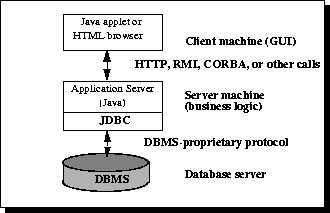The JDBC API is a Java API that can access any kind of tabular data,
especially data stored in a Relational Database.
JDBC helps you to write java applications that manage these three programming activities:
- Connect to a database
- Send queries and update statements to the database
- Retrieve and process the results with database.
Connection con = DriverManager.getConnection ( "jdbc:myDriver:wombat", "myLogin","myPassword"); Statement stmt = con.createStatement(); ResultSet rs = stmt.executeQuery("SELECT a, b, c FROM Table1"); while (rs.next()) { int x = rs.getInt("a"); String s = rs.getString("b"); float f = rs.getFloat("c"); }This short code fragment instantiates aDriverManagerobject to connect to a database driver and log into the database, instantiates aStatementobject that carries your SQL language query to the database; instantiates aResultSetobject that retrieves the results of your query, and executes a simplewhileloop, which retrieves and displays those results.
JDBC includes four components:
- The JDBC API
The JDBC™ API provides programmatic access to relational data from the Java™ programming language. Using the JDBC API, applications can execute SQL statements, retrieve results, and propagate changes back to an underlying data source. The JDBC API can also interact with multiple data sources in a distributed, heterogeneous environment.
The JDBC API is part of the Java platform, which includes the Java™ Standard Edition (Java™ SE ) and the Java™ Enterprise Edition (Java™ EE). The JDBC 4.0 API is divided into two packages:java.sqlandjavax.sql.Both packages are included in the Java SE and Java EE platforms.
- JDBC Driver Manager
The JDBCDriverManagerclass defines objects which can connect Java applications to a JDBC driver.DriverManagerhas traditionally been the backbone of the JDBC architecture.
The Standard Extension packagesjavax.namingandjavax.sqllet you use aDataSourceobject registered with a Java Naming and Directory Interface™ (JNDI) naming service to establish a connection with a data source. You can use either connecting mechanism, but using aDataSourceobject is recommended whenever possible.
- JDBC Test Suite
The JDBC driver test suite helps you to determine that JDBC drivers will run your program. These tests are not comprehensive or exhaustive, but they do exercise many of the important features in the JDBC API.
- JDBC-ODBC Bridge
The Java Software bridge provides JDBC access via ODBC drivers. Note that you need to load ODBC binary code onto each client machine that uses this driver. As a result, the ODBC driver is most appropriate on a corporate network where client installations are not a major problem, or for application server code written in Java in a three-tier architecture.




















